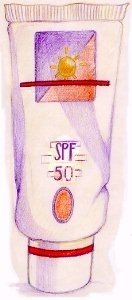Women’s Cancer Communication Project
Coordinated by the European Institute of Women’s Health
Skin Protection Information
Sunbeds
Many, particularly young women want to have a tan for cosmetic purposes and this has led to a large increase in the use of artificial tanning sunbeds. Sunbeds and tanning lamps, are artificial tanning devices that claim to give quick and harmless alternatives to natural sunlight. A growing body of evidence shows that ultraviolet (UV) radiation emitted by lamps, used in solariums, may damage skin and increase the risk of developing skin cancer.
Solar radiation and human health
132,000 cases of malignant melanoma (the most fatal skin cancer) and over two million cases of other skin cancers occur worldwide each year.
One in every three cancers diagnosed worldwide is a skin cancer.
Most skin cancers are related to over-exposure to natural UV radiation. Exposure to UV light, naturally from the sun or from artificial sources such as sunlamps, is a known risk factor for skin cancer. Short-wavelength UVB (280-315 nm) is recognised as carcinogenic in experimental animals, and increasing evidence shows longer-wavelength UVA (315-400 nm) used in sunbeds, which penetrates more deeply into the skin, also contributes to the induction of cancer.
Studies show a significant increase in the risk of malignant melanoma among women regularly using sunbeds. Additional exposure to UV from sunbeds is likely to enhance the well-known bad effects of excessive sun UV exposure. There is no evidence to suggest that UV exposure from any type of sunbed is less harmful than UV exposure from the sun.
Pre-cancerous actinic keratoses and Bowen’s disease have also been found in sunlight-protected but sunbed exposed skin in fair-skinned users after just two to three years of regular sunbed use.
Skin ageing, eye damage and other adverse health effects
Excessive exposure to UV, not just from sunbeds, can result in structural damage to human skin. In the short term this damage can be due to burning, fragility and scarring and in the longer-term as photoageing.
Photoageing is caused by the breakdown of collagen in the skin by UV and can cause wrinkling and loss of elasticity.
The effects of UV on eyes include cataracts, pterygium ( white coloured growth over the cornea) inflammation of the eye such as photokeratitis and photoconjunctivitis.
Excessive UV exposure can suppress your immune system, possibly leading to greater risks from infectious diseases.
Some skin types are unsuitable for tanning
Based on their susceptibility to sunburn, skin types are classified into six different classes (I – VI). People with skin type I – the lightest skin – may not get even a light tan after repeated exposure to sunbeds. Instead, their skin generally suffers sunburn reactions. People with skin type I are more likely to use sunbeds than people
with darker skin.
Consumer would not be able to recognize that their skin type is not suitable for sunbed use based on either their self-diagnosis, or worst, a bad experience of sunburn. Sunbed operators need training to ensure correct skin type diagnosis. While skin type II and higher can tan, skin damage can still occur following excessive exposure to UV.
Children and UV exposure
Childhood exposure to UV and the number of times a child is burnt by UV, either from the sun or sunbeds, are known to increase the risk of developing melanoma later in life. Children and adolescents should not use sunbeds.
The US Dept of Health has classified sunlamp or sunbed exposure as “known to be carcinogenic to humans” and states that the longer the exposure, the greater the risk, especially to people exposed before the age of 30 years.
About sunbeds
Sunbeds emit mostly UVA and some UVB, both of which can damage the DNA in cells of the skin. In recent years, lamps of sunbeds have been manufactured that produce higher levels of UVB to mimic the solar spectrum and speed the tanning process. While UVB has well known carcinogenic properties and excessive exposure is known to lead to the development of skin cancers, recent scientific studies suggest that high exposures to the longer wavelength UVA could also have an impact on skin cancer occurrence.
As with sun exposure, studies indicate a relationship between the use of sunbeds and malignant melanoma as well as non-melanoma skin cancers such as squamous and basal cell carcinomas.
So, the consequences of regular sunbed use may include disfigurement from the removal of skin cancers, early death, if the cancer is a malignant melanoma, as well as substantial costs to national health systems for screening, treating and monitoring skin cancer patients.
Health benefits
In rare, specific cases the medically-supervised use of sunbeds be considered. Medical UV devices can successfully treat certain skin conditions such as dermatitis and psoriasis. Treatments should be conducted by qualified medical supervision in approved medical clinics only, not unsupervised either in commercial tanning premises or at home using a domestic sunbed.
There is a false belief that a tan acquired using a sunbed will provide good skin protection against sunburn for holidays in sunny locations.
A sunbed tan offers limited protection against sunburn from solar UV, estimated as the same protective effect as using a sunscreen with a sun protection factor (SPF) of only 2-3.
Regulation governing sunbed use
While sunbeds are available to the public, there is a need for guidelines and / or legislation to reduce the risks associated with their use. There is a gorwing international call for encouraging governments to formulate and enforce effective laws governing the use of sunbeds. Where voluntary industry codes of practice exist, the sunbed owners have generally not shown significant capacity to self regulate effectively.
The highest regulatory priority is for the restriction of use by persons under 18 years and a ban on unsupervised trained personel.
Recommendations:
The following should definitely NOT use sunbeds or sunlamps:
- People who have skin phototypes I or II;
- Children ( less than 18 years of age);
- People who have large numbers of nevi (moles);
- Persons who tend to freckle;
- Individuals who have a history of frequent childhood sunburn;
- People who have pre-malignant or malignant skin lesions;
- People with sun-damaged skin;
- Those wearing cosmetics as these may enhance sensitivity to UV exposure;
- Persons taking medications. In this case they should seek advice from their physician to determine if the medication will make them UV-sensitive.
Cancom Index | Previous | Next



